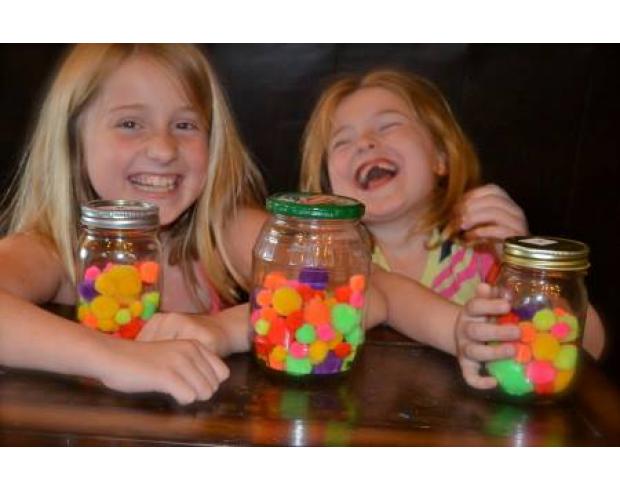The other night I was lying beside my 6-year-old daughter at bedtime when she snuggled in close and released a contented sigh. “I’m glad I have a family,” she whispered softly. After agreeing whole-heartedly with her beautiful statement, an unexpected question popped out of my mouth. “If you didn’t have a family, who would you want to live with?” I asked. Without hesitation, she rattled off four extraordinary women in our family’s life, including a current teacher and a past teacher. As we were discussing these special ladies, my oldest daughter popped into her sister’s room to return something she borrowed. “What are you talking about?” she inquired. When I told her what we were discussing, she immediately confirmed the value of a teacher in a child’s life by saying, “If I didn’t have a family, I would want to live with my teacher, Mrs. Reynolds.” I was not the least bit surprised that my daughters had great affection and trust for these particular teachers. I had been in their classroom many times. I saw the love they had for their students displayed in both words and actions on many occasions. On the day my youngest child came to school in her new glasses, her teacher did not wear her contact lenses as usual. She dug up her old glasses and wore them so my child would not feel alone. She did that for months—maybe even the remainder of the school year. To this day, my daughter still loves to wear her glasses, and she wears them with pride. I also remember how one of these special teachers noticed my oldest daughter was struggling with the organization of her assignments and loose papers. As soon as the teacher spotted the difficulty, she told my child, “When I was young, I was just like you. I had so many neat things going on in my brain it was hard to keep up with the papers.” As a team, my daughter and her teacher figured out a way to stay organized that my daughter still uses today. I could name countless ways these particular teachers chose to build on the positive when addressing my children’s differences, insecurities, and weaknesses rather than using condemnation to get them to change, conform, or improve. I am fortunate to have observed these extraordinary teachers when I most needed to be reminded of the power of positivity. Because I must admit, I was once prone to criticize my children under the guise of “good intentions.” Whether it was poor posture, unmannerly eating habits, improper grooming, uncoordinated outfits, or a less-than-desired performance in sports or music, these were all areas in which I felt the need to correct. I justified the criticism by saying I didn’t want my child to be teased … or I wanted her to be successful in life … or be well liked … or gain self-confidence. But truthfully, it was all about me. I was concerned about how my children’s behavior or appearance was going to reflect on me. I pushed for perfection because I was overly concerned about what other people were going to think me, not them. The truth hurts, but the truth heals. But that all changed the day my youngest daughter laid down her ukulele in the middle of a practice session. After much parental scrutiny and disapproval for the way she was playing, she just stopped. As if surrendering to a battle she could never win, my child said seven words I won’t forget as long as I live. “I just want to be good, Mama.” I just want to be good. My child, who has a genuine talent for playing the ukulele and an inherent love of singing, thought she was no good. And it was because of me—my critical words, my constant suggestions, and my disapproving looks. I had practically convinced myself that the corrections were building her up—when in reality, they were breaking her down. My child’s painful words revealed the destructive nature of criticism. Immediately, I thought of other instances when being overly critical caused regression, not improvement in my children. It became clear to me that constant corrections were not helping my children become more successful, more productive, more effective, or more fulfilled. Being critical was hindering my children’s gifts and causing them to be unsure of their abilities. Criticism was diminishing their unique lights that made them who they are. That’s when I decided no more. I wanted to notice the good. I vowed to return to being the positive and affirming person I was with my students throughout my teaching career. I went straight to our basement and dug through my stored teacher supplies. For nine years, I taught children with behavior problems and learning disabilities. There were many negative behaviors and mistakes that I could have been critical of, but I wasn’t. I strived to find at least one strength and one positive in each student everyday, and then I would focus and build on that. I tried to notice as many appropriate actions as I could and comment specifically on them. I used the positive approach for nine years because I saw it work miracles with troubled students that many people thought would never succeed. I dug through my teacher supplies until I found what I was looking for: The Warm Fuzzy Jar. There was a large crack on the side from one of our many moves as a family. I quickly decided I didn’t have to use this particular jar—just as this strategy for noticing positive behavior wasn’t just for classrooms! I went to the kitchen and found a large, empty pickle jar and filled it with the colorful pom-pom balls. Then I set two smaller jars beside it on the kitchen counter. Within minutes, my children noticed the jars and inquired about them. “This is The Warm Fuzzy Jar,” I explained. “Whenever you do something helpful or kind, you place a pom-pom ball in your designated jar because kind and helpful acts make people feel good, like a warm fuzzy.” The girls looked at each other with wide eyes and big smiles, so I continued. “And if you are doing something helpful together or just getting along nicely, you can put two pom-poms in your designated jar. And when your jar becomes full, you can choose something special for you and I to do together.” My children had the same reaction as my former students did to filling The Warm Fuzzy Jar—pure enthusiasm. They wasted no time being helpful. They carried in groceries that I typically brought in by myself. They put away shoes in the hallway that they used to step over for days. They made their beds in the morning without being told … dirty clothes actually made it to the hamper without my help … dishes made it to the sink (and even got rinsed) with helpful smiles … musical instruments were played without reminders to practice. There were even a few shockers like a surprise organization of my spice rack and a super clean toilet bowl. But that wasn’t all. The Warm Fuzzy Jar changed the atmosphere of our home. Cooperation and kindness seems to lighten everyone’s moods—most notably mine. The fuzzy, colorful balls made everyone more aware—aware of “doing good” and “noticing good.” I noticed that she dressed herself and hung the discarded clothes back on hangers—not the striped socks that didn’t match with the plaid shorts. I noticed that she was helping her sister write sentences—not that she was using a Sharpie that was turning her fingers black. I noticed that she prepared a healthy breakfast of cereal and cantaloupe—not the trail of milk that went all the way from the counter to the kitchen table. I noticed that she helped her sister do her hair—not the twelve barrettes that were secured haphazardly to the back of her head. I was Noticing the Good, and it was making a huge difference in our day-to-day interactions and my children’s overall wellbeing. After the jar worked its magic for a couple months, I put it away so the novelty would not wear off. But a week ago, as the children’s school year was coming to a close, I decided it was the perfect time to get the jar out again. The long, hot summer months can be challenging, and I need daily reminders to Notice the Good. In preparation for The Warm Fuzzy Jar return, I set the items on the kitchen counter. “The happy jars!” my youngest child shouted when she saw the jars and pom-poms on the counter. “When can we start filling them?” she asked excitedly. I shrugged, “Well, I was going to wait until the first day of summer vacation, but you can start today, if you’d like.” Both girls went right into action, and so did I—the children were “doing good” and I was “noticing good.” Once again, the powerful awareness lightened the entire atmosphere of our home and made us all more helpful and kind. Yesterday, I noticed the girls’ jars are already half full. Suddenly it occurred to me that the children hadn’t even declared what they would be earning when they filled their jar. To me, that fact spoke volumes. When it comes to positive affirmation—the prize doesn’t matter. Because being affirmed is the prize. Because having someone notice and celebrate your good work is the prize. Because seeing the smile on your parent’s face because of something you did is the prize. But wait. Here’s the real prize … When you fill up a child, her eyes become brighter. Her head is held higher. Her dreams come closer. And suddenly, life is full of possibilities for the most precious prize of all: your child.
2014-04-18 10:36:27
The other
sign in to comment
Be the first to comment





